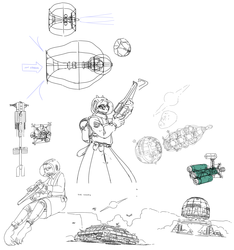Sign In
ClosePoor picture taken with a phone camera in lieu of a scanner, which I'll rectify tomorrow, but I wanted to post this for reference on Nocebo military orbit-orbit spacecraft, which enter combat in squadrons called Battle Constellations. This picture is meant to give an idea of the general scale of the vessels, especially the larger ones, which are drawn to scale with respect to each other - although not to the goat pilot nor the Lancer.
Huge warships in the Nocebo system are much more expensive than their smaller counterparts to build and maintain per unit mass, but they are preferred when possible for their much greater weapons capacity. Structural components and essential systems tend to grow more slowly with a ship's size than the ship itself, and while many combat spacecraft in the Destroyer mass-range go down to 15,000 tons total mass - roughly the size of a modern destroyer - the largest spacecraft range into the 150,000-ton class, larger than a modern Nimitz supercarrier. For any of these ships, 3/4 of this mass is actually propellant, leaving around ~4,000-40,000 tons of actual ship. However, larger ships can field up to 20,000 tons of weapons systems, or Lancers, while the smallest ships can field only 500.
The six main warship types' roles within a Battle Constellation can be summarized like so:
• Sentinel: Observatory spacecraft that coordinate the Constellation's maneuvers and track enemy movements, using large Hubble-sized optical telescopes as well as various smaller ones. They carry more heliograph-signaling equipment than the other spacecraft, visible as rectangles mounted on stilts jutting out from the ship's hull. Sentinels may serve more as a command center, or they may be geared more toward observation duty. They carry large crew complements and relatively light payloads of weapons, but wield beefier engines and more propellant to help them avoid threats.
• Minestar: These vessels are the first combatants in a battle, and fire shots long before any other ship in a Constellation. Minestars carry large payloads of mineshot, which can be likened to gigantic shotgun shells filled with large spheres of iron shot. These spheres' large, solid mass and simple design allows them to be cheaply manufactured to puncture enemy hulls without being slowed or vaporized by armor. Once launched, a clockwork timer is activated within the mineshot to trigger a detonation that scatters the iron spheres along a wide cone of trajectories. These ships have few other weapons and are operated by a skeleton crew.
• Destroyer: The smallest class of proper warship, Destroyers field anywhere from 500 tons of armament up to the mid-thousands, which can include mineshots, and may be regarded as a template for the larger two classes. A cluster of up to seven nuclear liquid-core engines drives the spacecraft to thrust at up to three gees of acceleration, around the maximum survivable by Nocebo sapients at long durations. Huge gun turrets line the spacecraft's exterior at regular intervals all around its circumference, with 24 of them on this model providing full coverage of the spacecraft's surroundings. Destroyers that are refitted for journeys into the Outer System are called Deep-System Cruisers.
• Battleship: Larger sisters of the Destroyers that field anywhere from thousands to ~20,000 tons of weaponry. Their guns are bigger, more numerous, and they can dominate over many equivalent Destroyers with firepower and armor, although they cost proportionally much more.
• Carrier: These massive hulls carry Lancers as fighter-bombers. They can be built of any size, but in modern times it is generally only Battleship-size hulls that are considered Carriers.
All Nocebo largest-scale spacecraft are powered by liquid-core nuclear-mechanical reactors, which operate in a constantly molten state that helps heat a spacecraft's propellant liquid to high temperatures, making it shoot out the rocket nozzle faster and accelerate a spacecraft more efficiently. Without electronics, they are armed with kinetic weaponry, and use Lancers as a form of guidance to deliver warheads more directly to a target. Orbit-orbit artillery mounted on large spacecraft include combustion light-gas guns, a chemical-powered system offering accelerations similar to a railgun, as well as gyroscopically stabilized rockets. Machine guns are mounted as CIWS.
Submission Information
- Views:
- 681
- Comments:
- 5
- Favorites:
- 3
- Rating:
- General
- Category:
- Visual / Traditional
Comments
-
-

Computers are a critical part of the setting, actually! My ideas for them remain somewhat vague but the gist of it is "miniaturized, fully mechanical forms of the logic circuits used in the Zuse Z-1". I'd reckon a simple mechanical computer probably could be made small enough to fit onto a Lancer-class missile, but the key problem without electronics is detection. I have yet to find any suitable system that would reliably turn the miniscule light gathered by an astronomical telescope into a mechanical signal, which would be necessary in order to develop any fully automated targeting equipment. Hence, Lancers.
-

Detection? Is it going to be a part of a radar or an automated visible light communication/auto-guidance system?
For radar, you can make a rotating periscope with a prism system, which concentrates light to a disc with foxfire bacterial coating gel. Bio-luminescent bacteria will react to tiny amounts of light and you'll have a trail of green light synchronized with periscope's rotation, similar to 1940s phosphorous radar screens. Alternatively, a real phosphorous screen can be used, and light can be amplified by a rare-earth glass fibre optical amplifier.
For auto-guidance, things can get kinda tricky.
If that computer uses relays as logic gates and electricity as command lines, you can convert light to electricity using a simple vacuum tube detector, or an even simpler photoresistor. An oscillator can demodulate modulated light signal back to flight information. For weak signals use an amplifier, or a bigger detector.
If the computer uses micro pneumatic valves as gates and compressed air as command lines, then you're in deep trouble. Not only you'd have to transduce light into pressure, but you'll also have to amplify it somehow. I can imagine a simple light-to-pressure transducer, made of kilometer-wide mirrors plates which concentrate photon pressure to an extremely flexible diaphragm, but that can only be used to detect presence of huge light sources (stars and highly reflective objects). You'll probably be better off with an optical light amplifier, coupled to a mechanical light oscillator which demodulates the signal into Morse code or voice signal. Lance pilot could navigate by station navigator's voice.
-

The problem with radar is that without electricity, there's no way to emit a signal, and its usefulness would be limited over an optical telescope anyway.
If the computer uses micro pneumatic valves as gates and compressed air as command lines, then you're in deep trouble.
It uses mechanical parts - shafts, gears, compressed air, whatever need be, but it doesn't use electricity. Yes, that is what I was getting at.
You'll probably be better off with an optical light amplifier, coupled to a mechanical light oscillator which demodulates the signal into Morse code or voice signal. Lance pilot could navigate by station navigator's voice.
That is something that I have considered and I've decided that the simplest way to deal with the issue is to have the Lancer pilot use optical telescopes to keep track of the battlefield, and control the vessel either manually with mechanical assistance and/or via entering parameters into the computer. Contact with the mothership is maintained via Morse transmission using ultra-lightweight heliographs, probably Mylar or similar material.
This submission is more than a year old, and as I've noted elsewhere a lot of the solutions to problems with the equipment are just things I haven't published much info on yet. :P But thanks for the elaboration.
-
-
-



![Goat spacesuit [Bubbleverse]](https://cdn.weasyl.com/static/media/5c/f5/a9/5cf5a9408e43c3731c9ea747bed63ee64af063993219e64e6fe009cb666f6bb4.png)
Link
kishniev
No electronics doesn't mean no computation. They could be using mechanical spring-operated computers, or computers based on pneumatic valves and air flow instead of transistors and electrical current.
The key branch in technology of computing is, if we are to trust a living person more than we trust a machine. You know the results of Butlerian Jihad? That kind of decision.